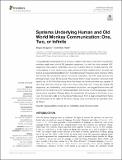Systems Underlying Human and Old World Monkey Communication: One, Two, or Infinite
Author(s)
Miyagawa, Shigeru; Clarke, Esther
DownloadPublished version (585.1Kb)
Terms of use
Metadata
Show full item recordAbstract
Using artificially synthesized stimuli, previous research has shown that cotton-top tamarin monkeys easily learn simple AB grammar sequences, but not the more complex AnBn sequences that require hierarchical structure. Humans have no trouble learning AnBn combinations. A more recent study, using similar artificially created stimuli, showed that there is a neuroanatomical difference in the brain between these two kinds of arrays. While the simpler AB sequences recruit the frontal operculum, the AnBn array recruits the phylogenetically newer Broca's area. We propose that on close inspection, reported vocal repertoires of Old World Monkeys show that these nonhuman primates are capable of calls that have two items in them, but never more than two. These are simple AB sequences, as predicted by previous research. In addition, we suggest the two-item call cannot be the result of a combinatorial operation that we see in human language, where the recursive operation of Merge allows for a potentially infinite array of structures. In our view, the two-item calls of nonhuman primates result from a dual-compartment frame into which each of the calls can fit without having to be combined by an operation such as Merge.
Date issued
2019-09Department
Massachusetts Institute of Technology. Department of Linguistics and PhilosophyJournal
Frontiers in Psychology
Publisher
Frontiers Media SA
Citation
Miyagawa, Shigeru and Esther Clarke. "Systems Underlying Human and Old World Monkey Communication: One, Two, or Infinite." Frontiers in Psychology 10 (September 2019): 1911 © 2019 Miyagawa and Clarke
Version: Final published version
ISSN
1664-1078